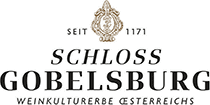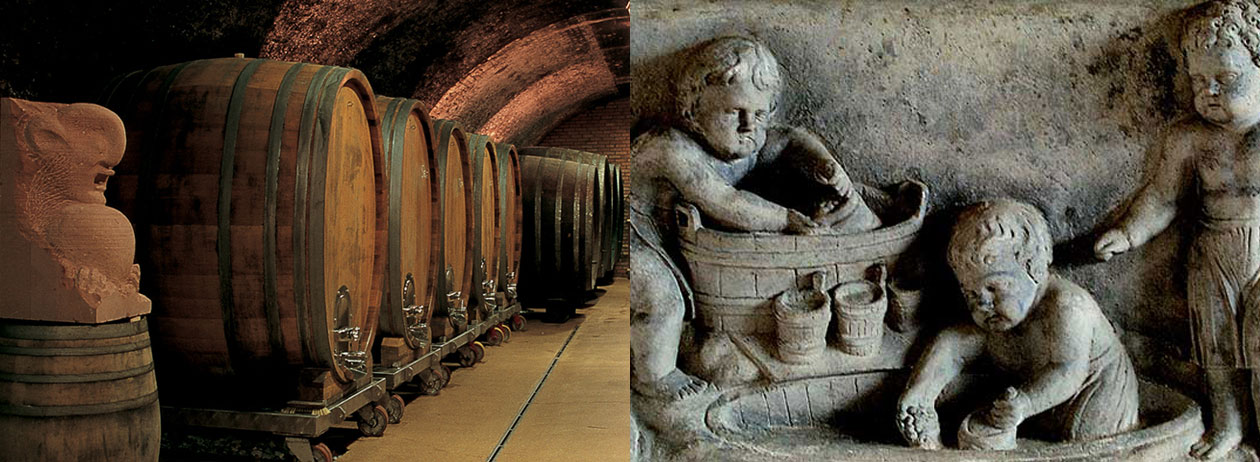HISTORY
1171 The monks of the Zwettl monastery are granted their first vineyards at the Heiligenstein and Gaisberg.
1740 The castle and its vineyards are acquired by the order.
1786 After a fire at the Kammern winery, winemaking is transferred to Gobelsburg.
1996 Michael & Eva Moosbrugger take over the management of the property together with Willi & Edwige Bründlmayer. The winery is admitted to the association Österreichische Traditionsweingüter.
“Qui bon vin boit, Dieu voit.” (Saying of the Cistercians)
The very early history of the castle Gobelsburg and its vineyards is an unwritten story as with many similar estates in Austria. Archeological excavations in one of our vineyards (Grub) and during the extension of the chateau’s vaults have released many traces of settlements in eolithic, bronze and iron age, the Roman empire and early medieval periods.
1074
The castle was first mentioned in a contract dated 1074 in relation to Azzo de Gobatsburich, Earl of Kuenring. The property remained in the possession of the Kuenring family until the end of the 12th century when it changed hands to the Felsberg-Falkenstein family as a dowry for the last lady Kuenring. In the 15th century the Habsburgs, the reigning Dukes of Austria took possession of the estate. During the flourishing regimen of the Habsburg, then German Emperors, the fortified castle Gobatsburg was torn down to be replaced by a Renaissance manor house. It changed hands again only 100 years later.
When Stift Zwettl, a Cistercian monastery, was founded by Earl Hadmar I of Kuenring in 1137 the monks were bestowed with forests and land around Zwettl in the heart of Waldviertel as well as with vineyards and arable land in Kammern near Langenlois and the rivers Kamp and Danube. The oldest known vineyard in the region is mentioned in this deed of donation, ie the Allerheiligenstiftung.
1440
Between 1074 and 1740 there were as many as 19 different families on the estate and castle Gobelsburg. The last aristocratic owner Freiherr Achaz Ehrenreich von Hohenfenfeld initiated the alterations of the Renaissance manor house into a handsome Baroque chateau in the first half of the 18th century.
The basic structure – two-storied 4 wings around a courtyard – stayed as it was. Renaissance features can still be seen today with the arcade in the courtyard and the vaulted Sala Terrena. The main modifications made were very delicate Baroque ornaments on the three facades and huge tiled stoves thematically harmonized with stucco and painted ceilings in most of the rooms.
1740
The small terraced garden was most likely added at the same time based on the style of the decorative watchtowers and box hedges.
The reconstruction that was planned and carried out by the famous architect Josef Munggenast (Melk, Zwettl, Altenburg) caused severe financial difficulties for the family Ehrenreich-Hohenfeld, hence why in 1740 the son of Baron Achaz entered the monastery of Zwettl in hopes that they would take over the property along with its debts.
In 1784 the two estates of Stift Zwettl, Kammern and Gobelsburg, were merged and began operating as “Schloss Gobelsburg Weingut des Cistercienser Stift Zwettl” from that point on. Since then Gobelsburg has become one of the leading and most distinguished wineries in Austria.
1918-1945
Between World War I and II the chateau was (mis) used as a summer youth camp, during World War II French POWs were quartered at the estate. No major damages occurred during the war. However, during the following Soviet occupation the officers made a sport of shooting into the front facade. Today the chateau has once again been restored to its prior glory and is a popular venue for cultural events, as well as family and company functions.
1958
Father Bertrand Baumann put the restoration of the estate, its reputation, as well as its return to prominence at the forefront during his time at the winery. He brought Cistercian tradition to Gobelsburg with the introduction of the Burgundian vine Pinot Noir achieving outstanding results despite the laborious and complex cultivation the varietal requires. He also established Gobelsburger Messwein (altar wine) as an Austrian classic. This particular wine is a light and crisp Grüner Veltliner that is produced in strict accordance to ecclesiastical regulations in concern to vineyard and cellar techniques, ie organically sensitive work in the vineyards, no chaptalization or additives. Father Bertrand served as Abbot of Stift Zwettl from 1980 until 1994 when he finally resigned due to age. Altabt” Father Bertrand is still proudly and joyfully inspecting the vineyards and cellars here today.
1996
In January 1996 Schloss Gobelsburg – the estate and its vineyards – were acquired by Willi Bründlmayer and Michael Moosbrugger through a long-term lease. Today the estate and winery are managed by Michael.
Some of Austria’s finest vineyards belong to Schloss Gobelsburg, these being the vineyards on the terraced Heiligenstein and Gaisberg as well as the hollow site between the two hills, the Grub.
The terroir of these hills and hollow sites are very diverse – each exemplifying their own unique nuances. The hills have porous rocky soil containing mica-schist and gneiss, as well as basalt in some places on the Heiligenstein. The soil within the hollow is fertile loess 4 to 8 meters deep. On the adjoining lower sites there is loess and loam mixed with some brown and sandy soil. The Gobelsburg plateau which is south of the château, has vineyards that rest upon pebbles and gravel that was transported here by the “early Danube.” Additionally, there is a topsoil of about 0.5 to 1.0 meter consisting of black and loamy soil and loess.

